#bangkok art biennale
Explore tagged Tumblr posts
Text
Bangkok Art Biennale 2024 "Nurture Gaia"

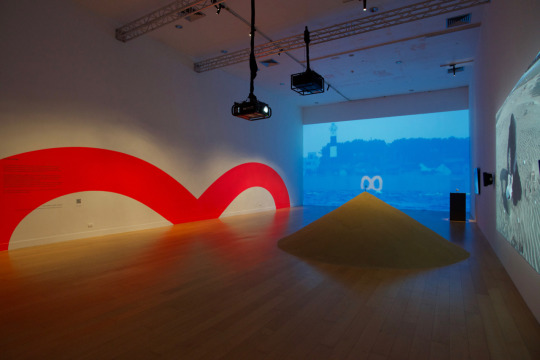
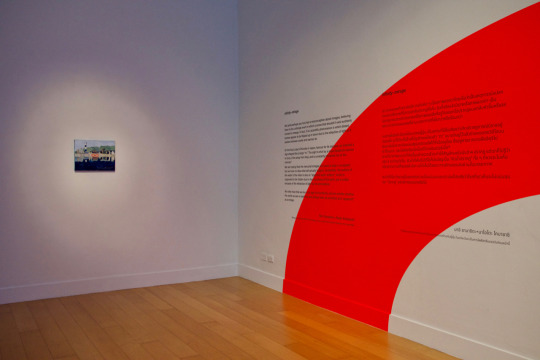
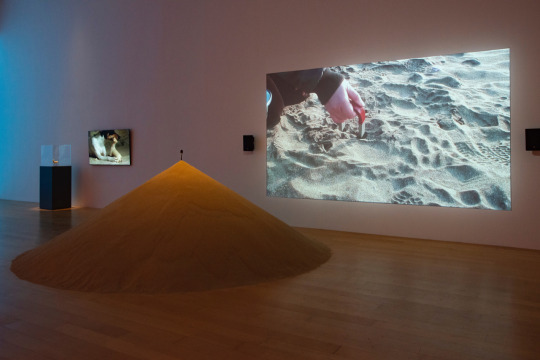
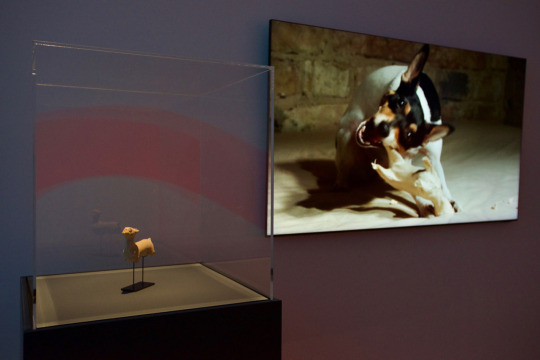
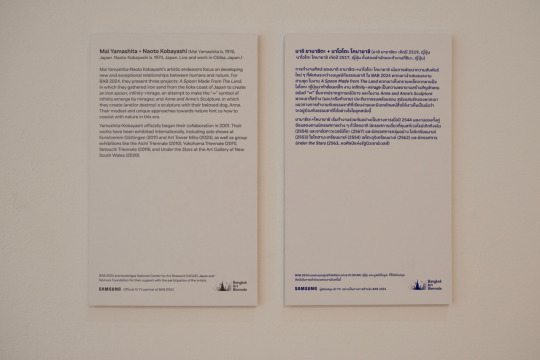
We are participating in Bangkok Art Biennale "Nurture Gaia"! Our installation consists of "infinity~mirage", "A Spoon Made From The Land" and "Anne and Anne's Sculpture".
Venue: Bangkok Art and Culture Centre (BACC) Date: Oct.24, 2024 - Feb.25, 2025 Web: https://www.bkkartbiennale.com Artists: Adel Abdessemed (Algeria / France), Haritorn Akarapat (Thailand), Agnes Arellano (The Philippines), Aideen Barry (Ireland), Ari Bayuaji (Indonesia / Canada), Joseph Beuys (Germany), George Bolster (Ireland / USA), Louise Bourgeois (France / USA), Jennie Bringaker (Norway), Dante Buu (Montenegro / Germany), Chiara Camoni (Italy), Choi Jeong Hwa (South Korea), Isaac Chong Wai (Hong Kong / Berlin), Susan Collins (UK), Amanda Coogan (Ireland), Priyageetha Dia (Singapore), Guerreiro do Divino Amor (Switzerland / Brazil), Nick Dudka (Russia), Elmgreen & Dragset (Denmark and Norway), Pejvak Collective (Iran / Canada / Russia), Chitra Ganesh (USA), Amanda Heng (Singapore), Camille Henrot (France / USA), Dusadee Huntrakul (Thailand), Aki Inomata (Japan), Yanawit Kunchaethong (Thailand), Prasong Luemuang (Thailand), Kira O’Reilly (Ireland / Finland), Bagus Pandega & Kei Imazu (Indonesia / Japan), Princess Marsi Paribatra (Thailand), Bounpaul Phothyzan (Laos), Abraham Poincheval (France), Ravinder Reddy (India), Lisa Reihana (New Zealand), Taiki Sakpisit (Thailand), Nuttapon Sawasdee (Thailand), Jessica Segall (USA), David Shongo and Filip Van Dingenen (Congo / Belgium), Pim Sudhikam (Thailand), Som Supaparinya (Thailand), Young-jun Tak (South Korea), Jedsada Tangtrakulwong (Thailand), Supawich Weesapen (Thailand), WISHULADA (Thailand), Mai Yamashita+Naoto Kobayashi (Japan)
0 notes
Text
this trio goes back 11+ years 🥰
#offtay#off jumpol#tay tawan#x nuttapong#thai actors#gmmtv#byofftay#2024#so you're telling me I could've seen offtay at the bangkok art biennale in my fave museum?????? I would've passed out wtf
5 notes
·
View notes
Text
#refugees#shan refugees#myanmar#venice biennale#bangkok biennale#thai artist#themes of displacement and diaspora#textile project#the spirits of maritime crossing exhibition#art
0 notes
Text
The Bangkok Buzz
Thailand is a country known for its vibrant culture, stunning landscapes, and dynamic events that attract visitors from around the world. From colorful festivals to bustling markets and exciting sports competitions, there is always something happening in this Southeast Asian nation. Whether you're a traveler planning your next trip or simply interested in learning more about Thai culture, keeping up with the latest Events in Thailand can provide valuable insights into what makes this country so special.
One of the most famous events in Thailand is the Songkran Festival, which marks the traditional Thai New Year. Celebrated in mid-April, this lively festival is best known for its nationwide water fights, where locals and tourists alike take to the streets armed with water guns and buckets. Beyond the fun and games, Songkran also holds deep cultural significance, with rituals such as pouring scented water over Buddha statues and paying respects to elders. Another major celebration is Loy Krathong, held on the evening of the full moon in November. During this festival, people release beautifully decorated floating baskets, or krathongs, into rivers and lakes as a way to let go of negativity and make wishes for the future.
For those interested in arts and performances, the Thailand International Jazz Festival is a must-see event. Held annually in Bangkok, this festival brings together world-class jazz musicians for unforgettable nights of music under the stars. Similarly, the Bangkok Art Biennale showcases contemporary art from both Thai and international artists, transforming the city into a massive open-air gallery. Food lovers, on the other hand, won’t want to miss the World Gourmet Festival, where top chefs from around the globe present exclusive dining experiences featuring exquisite dishes paired with fine wines.
Sports enthusiasts also have plenty of Events in Thailand to look forward to, such as the Bangkok Marathon, which draws thousands of runners each year. The route takes participants past some of the city’s most iconic landmarks, offering a unique way to experience the capital. Muay Thai, Thailand’s national sport, is another major attraction, with stadiums across the country hosting thrilling matches that showcase the skill and discipline of the fighters. For adventure seekers, events like the Phuket Triathlon combine swimming, cycling, and running against the backdrop of the island’s breathtaking beaches.
In addition to these annual events, Thailand also hosts numerous trade fairs and exhibitions that cater to business travelers and industry professionals. The Bangkok International Trade & Exhibition Centre (BITEC) is a hub for events ranging from tech expos to fashion shows, providing opportunities for networking and innovation. Meanwhile, local night markets like those in Chiang Mai and Pattaya offer a more casual but equally exciting atmosphere, with street food, live music, and handmade crafts creating a lively vibe.
No matter what time of year you visit, Thailand’s diverse calendar of events ensures there’s always something new to discover. Whether it’s the spiritual richness of traditional festivals, the creativity of art and music gatherings, or the adrenaline rush of sports competitions, each event offers a unique glimpse into the heart of Thai culture. To stay updated on the latest happenings, be sure to check out Events in Thailand for detailed guides and recommendations. With so much to see and do, Thailand continues to captivate visitors with its endless array of unforgettable experiences.
0 notes
Text
0 notes
Text
Daniela Comani’s YOU ARE MINE is a deeply impactful installation featured at the Bangkok Art Biennale 2024. By reworking the visual and textual language of media outlets, Comani reframes real-life news articles to spotlight issues of gender, patriarchy, and power dynamics.
This site-specific series confronts the audience with stories of violence and femicide, echoing alarming statistics from Thailand in 2023: 75% of domestic violence cases were against women. Through her work, Comani forces us to question societal narratives and recognize the urgent need for change.
Displayed as inkjet prints on matte vinyl stickers, her pieces are a stark reminder of the pervasive violence that often hides in plain sight. Art that speaks. Art that confronts. Art that demands change.
See it now at #BAB2024 👉🏼
#BangkokArtBiennale #ContemporaryArt #GenderEquality #ArtForChange #FeministArt #YOUAREMINE #DanielaComani #DenisDefrancesco #ArtVisit #ArtExhibition #ArtAndSociety #SocialJustice #EndViolence #ArtThatSpeaks #EmpowermentThroughArt
0 notes
Text
A King’s Clock Adorns the Bangkok Biennale
The French-made timepiece, on display for the art event, was one of many ordered by Rama V in 1873 as gifts for some Buddhist monks. Source link
0 notes
Text
others
— talking
2021.10.09 : "Mark(s) of Modernity Interconnected" In Conversation with Paphop Kerdsup and Nakrob Moonmanas @ Gallery VER (Facebook Live) organised by Gallery VER as part of the solo exhibition "The Tenebrous Spiral Staircase of the -" by Chitti Kasemkitvatana
2018.09.28 : "Internet Universality Beyond Words: A Roundtable Discussion on Artistic Freedom" In Conversation with Duong Bich Hanh, Misako Ito, Wee Viraporn, Paphop Kerdsup, Nippita Pongern, Siriwat Pokrajen, Sorayos Prapapan, Pen-ek Ratanaruang, and Anucha Boonyawatana @ Function Room, Thailand Creative & Design Center (TCDC) Bangkok organised by UNESCO Bangkok as part of the group exhibition "Internet Universality Beyond Words" curated by Sali Sasaki and Manuporn Luengaram
— moderating
2023.10.24 : ALL THINGS ART "What Is Research-Based Art Practice?" In Conversation with Chitti Kasemkitvatana and Som Supaparinya @ Soho House Bangkok organised by Soho House Bangkok
2023.02.11 : BAB Talk "Research-based Art Practice: Reading Diffractively" In Conversation with Dr Apinan Poshyananda, Chitti Kasemkitvatana, and Nut Srisuwan @ The Prelude One Bangkok organised by Bangkok Art Biennale 2022 in collaboration with One Bangkok
2021.03.13 : BAB Talk "Revisiting Dusit Thani in the 21st Century: A (Model) City for Democracy of King Rama VI" In Conversation with Prateep Suthathongthai, Churporn Rangavara, and Dr Pirasri Povatong @ The Prelude One Bangkok organised by Bangkok Art Biennale 2020 in collaboration with One Bangkok
2020.11.30 : ACT FORUM 2020 "Value and Happiness Creation from BASTARD ARCHITECTURE" In Conversation with Chatpong Chuenrudeemol of CHAT architects @ IMPACT Challenger Hall 3, IMPACT Arena Muang Thong Thani organised by the Architect Council of Thailand (ACT)
0 notes
Text
Marina Abramović in mostra a Londra: «Sono stufa del sistema. Gli artisti dovrebbero avere libertà di espressione»
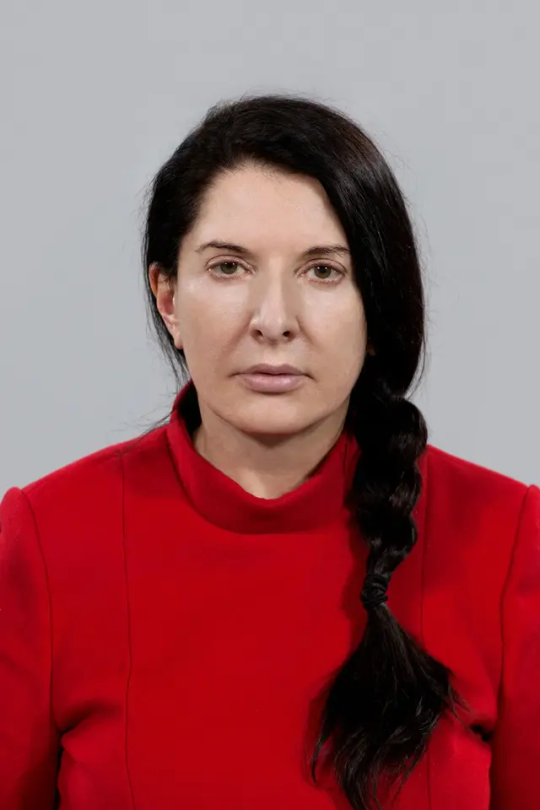
Prima donna a esporre nelle gallerie principali della Royal Academy of Arts, Marina Abramović corre veloce tra film, un marchio di benessere spirituale e due libri in uscita. Eppure, quando cucina, dimentica il timer
DI��AMEL MUKHTAR 27 ottobre 2023
Marina Abramović e la sua mostra a Londra, una delle più esaustive
All’improvviso, a metà del flusso di pensieri, Marina Abramović ha un sussulto e balza in piedi. Per un attimo, pensiamo che l’impavida artista concettuale stia avendo una rivelazione. «Il pollo!», esclama. Mentre lei corre in cucina, lo schermo mostra le pareti bianche della sua casa a nord di New York, con le grandi finestre affacciate sul verde. Poi, Abramović riappare. «Completamente bruciato», annuncia avvilita. «Avevo programmato di mangiare pollo e insalata. Mi resta solo l’insalata».
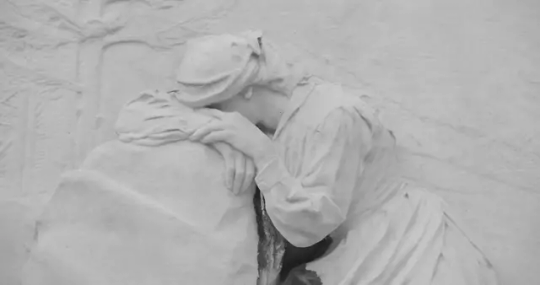
Spirits of Maritime Crossing, 2023 (still from video)Image courtesy Bangkok Art Biennale Foundation
Non solo installazioni: 7 Deaths of Maria Callas all’English National Opera
A sua parziale giustificazione, va detto che Abramović ha molte cose a cui pensare in questo momento. Alla fine di settembre ha inaugurato la sua storica retrospettiva nelle Main Galleries della Royal Academy of Arts di Londra – è la prima donna a tenervi una mostra personale nei 255 anni di storia dell’istituzione – mentre a novembre porterà all’English National Opera lo spettacolo 7 Deaths of Maria Callas. Il cortometraggio The Spirits of Maritime Crossing, scritto e realizzato da Apinan Poshyananda con lei come protagonista, è stato presentato al St. Moritz Art Film Festival. Ci sono poi le performance che, sempre a Londra, sta curando per il Southbank Centre insieme a 12 studenti del suo Marina Abramović Institute e, ancora, i due libri che ha pubblicato (Marina Abramovic: A Visual Biography e Marina Abramovic: Nomadic Journey and Spirit of Places). Senza dimenticare i suoi prodotti di benessere spirituale, chiamati Longevity Method, il cui lancio è imminente. Come fa la 76enne artista serba a gestire tutto questo? La risposta è preceduta da una risata gutturale: «Non ho un marito rompiscatole che mi aspetta a casa», spiega. «Non ho nemmeno dei figli. Ho solo il lavoro. Ho iniziato a fare arte a 12 anni, e da allora ho lavorato e basta».
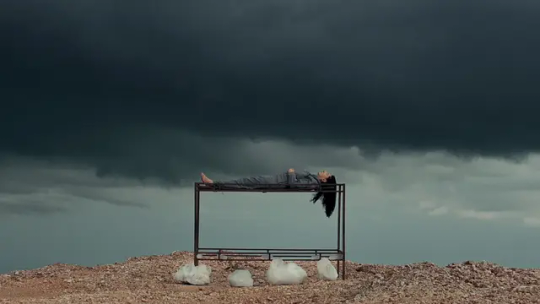
Un frame del video The Current, 2017Courtesy of the Marina Abramović Archives
New York - Londra, via mare
Non si ferma nemmeno quando rischia la vita. «Qualche mese fa, ho subito una brutta operazione al ginocchio», racconta. «Mi ha causato un’embolia». Il medico le aveva proibito di volare per almeno sette mesi, una limitazione inaccettabile per lei: «Sono una persona che prende un aereo ogni tre giorni!». Così, ha trovato una soluzione alternativa per raggiungere Londra: è arrivata da New York a bordo della nave Queen Mary, un viaggio di sette giorni. «È stato fantastico», ricorda con entusiasmo. «Nessuna restrizione riguardo ai bagagli e un opuscolo di 20 pagine sulle attività disponibili a bordo: giochi di ruolo in stile Agatha Christie, stand-up comedy... Tutte cose nuove per me».

Four Crosses: The Evil (positive), 2019.Courtesy of the Marina Abramović Archives
La retrospettiva: 50 anni di carriera
La retrospettiva londinese include opere fondamentali realizzate nei suoi oltre 50 anni di carriera, tra cui video, sculture, fotografie, ma anche riproposizioni delle sue performance artistiche da parte di giovani creativi, oltre a un nuovo lavoro. Ma non tutto è come vorrebbe: «C’è un’installazione che si intitola Luminosity in cui l’artista deve sedersi nuda su un sellino di bicicletta fissato a una parete, una performance molto difficile. Ai miei tempi, ero in grado di resistere per sei ore. Adesso, il tempo massimo consentito è di trenta minuti, così i performer devono fare i turni». E aggiunge con un sospiro nostalgico: «Ah, gli artisti performativi degli anni 70! Nessuna delle loro opere sarebbe possibile oggi. Sono davvero stufa del sistema. Gli artisti dovrebbero avere libertà di espressione, ma ce l’hanno tolta». Ricorda che, per preparare la sua celebre mostra del 2010 The Artist Is Present, aveva dovuto allenarsi «come un astronauta» per un anno intero. «Voleva dire non mangiare né bere durante il giorno, ma solo la notte, perché non potevo muovermi nel corso della performance», spiega. «Ho dovuto cambiare completamente il mio metabolismo».
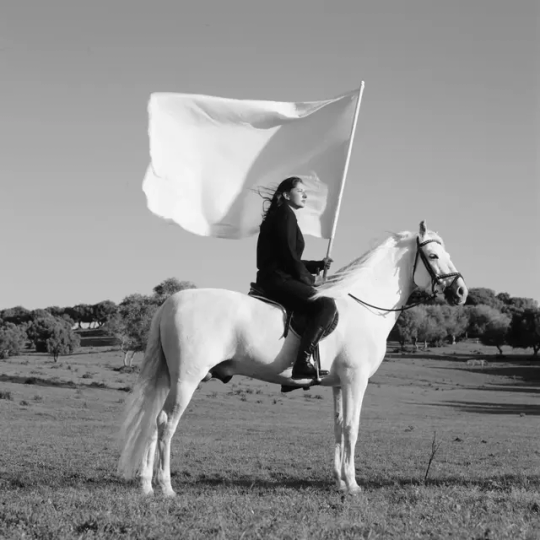
The Hero, 2001Courtesy of the Marina Abramović Archives. © Marina Abramović
Gli eredi della Abramović e il superamento dei limiti
Tuttavia, al Marina Abramović Institute, c’è una nuova generazione che sta imparando i suoi metodi di superamento dei limiti, ripetendo all’infinito le medesime azioni: aprire e chiudere una porta il più lentamente possibile nell’arco di tre ore o contare chicchi di riso per sei... «Quando lo fai più e più volte, a un certo punto la porta non è più una porta: è come se la tua mente si aprisse e l’universo ti si rivelasse. È un’esperienza che ti trasforma completamente». Il suo approccio integra varie pratiche apprese dalle comunità con cui è entrata in contatto nel corso dei suoi viaggi, dai monaci tibetani agli aborigeni dell’Australia, fino agli sciamani del Brasile. «È necessario aprire la mente perché il tuo lavoro dia dei frutti».
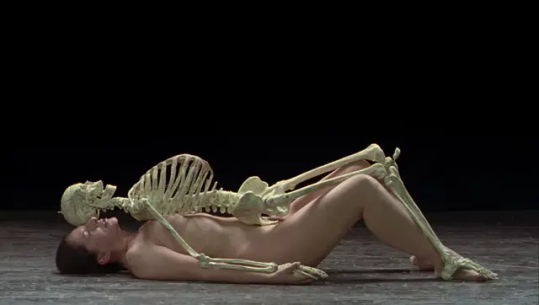
Nude with Skeleton, 2005.Courtesy of the Marina Abramović Archives. © Marina Abramović
«Non ho nessuna intenzione di andarmene»
Di questi “frutti”, al momento, è tappezzata tutta Londra. «È una pressione enorme», confessa. «Per due secoli e mezzo nessuna donna ha tenuto una personale negli spazi espositivi principali della Royal Academy of Arts. Sì, Tracey Emin ha esposto alla RA, ma in una location più piccola, e credo sia stata un’ingiustizia, perché questa grande artista britannica avrebbe meritato maggiore visibilità». L’indignazione evapora in un attimo, lasciando il posto al suo vivace senso dell’umorismo: «Beh, è anche vero che sono più vecchia di lei», ammette. «Forse vogliono dedicarmi una mostra prima che io muoia. Ecco perché è toccato a me». In tal caso, si tratterebbe di una premura ingiustificata: «Non ho nessuna intenzione di andarmene», precisa. «Almeno fino a quando non avrò 103 o 104 anni».

Balkan Baroque, June 1997Courtesy of the Marina Abramović Archives. © Marina Abramovi
Oltre a Marina Abramović e la sua mostra a Londra leggi anche
Saint Moritz Art Festival dove Marina incontra un monaco
Pittura Italiana Oggi: una mostra alla Triennale con 100 e più artisti da conoscere
Mark Bradford, la sua ultima mostra è una potente riflessione sul potere
Elena Bellantoni è l'artista che ha creato l'installazione per l'ultima sfilata Dior, tra pop e politica
1 note
·
View note
Text
Zarina
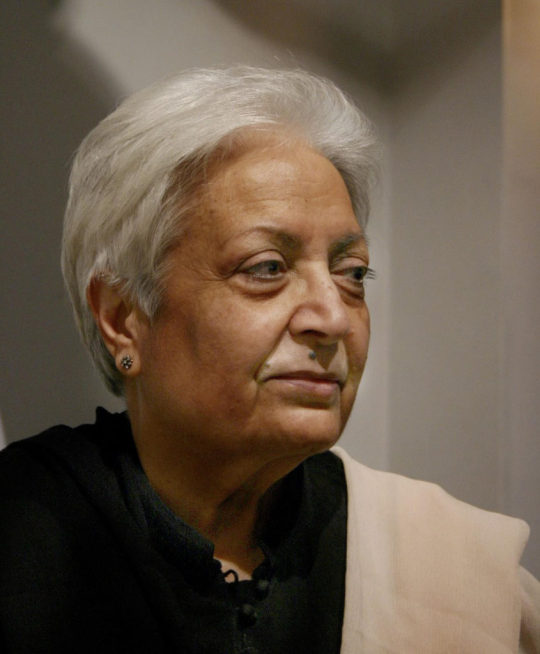
Memory is my only possession.
Zarina è stata l’artista proveniente dal Sud Est Asiatico più conosciuta e rappresentata.
Le sue opere si possono ammirare nelle collezioni permanenti di importanti istituzioni culturali come la Tate Gallery, il Guggenheim, il Metropolitan Museum of Art, il Whitney Museum e il MoMa.
Spaziando tra disegno, incisione e scultura, il suo stile è caratterizzato dall’utilizzo di forme astratte e geometriche.
Nata il 16 luglio 1937, col nome di Zarina Rashid, a Aligarh, nella regione dell’Uttar Pradesh, in India, dopo la spartizione del paese, nel 1947, è fuggita con la famiglia a Karachi, nel neonato Pakistan.
A 21 anni ha sposato un diplomatico da cui ha preso il cognome Hashmi che ha seguito in giro per il mondo. Ha vissuto a Bangkok, Parigi, Bonn, Tokyo, dove si è immersa in movimenti artistici come il modernismo e l’astrazione.
Trasferitasi a New York nel 1976, ha iniziato a frequentare e sostenere i movimenti delle donne e antirazzisti, entrando a far parte dell’Heresies Collective, pubblicazione femminista che esplorava l’intersezione tra arte, politica e giustizia sociale.
Ha insegnato al New York Feminist Art Institute e, nel 1980, ha contribuito a curare una mostra alla AIR Gallery intitolata Dialectics of Isolation: An Exhibition of Third World Women Artists of the United States che ha dato rilievo al lavoro di artiste provenienti da quello che, allora, veniva definito ‘Terzo Mondo‘.
Il lavoro di Zarina ha esplorato il concetto di casa come spazio fluido e astratto che trascende la fisicità o il luogo. È spesso caratterizzato da simboli che richiamano alla mente idee come il movimento, la diaspora e l’esilio, come iscrizioni nella sua lingua nativa, l’urdu, o elementi geometrici ispirati all’arte islamica.
Nel 2011, è stata tra i quattro artisti e artiste a rappresentare per la prima volta l’India alla Biennale di Venezia.
L’Hammer Museum di Los Angeles, nel 2012, ha organizzato la prima retrospettiva sul suo lavoro dal titolo Zarina: Paper Like Skin, in mostra anche al Solomon R. Guggenheim Museum, all’Art Institute of Chicago e alla Pulitzer Art Foundation di Saint Louis.
Numerosi sono stati i riconoscimenti ottenuti per la sua arte e impegno.
Per la critica occidentale, la sua opera rappresenta una fusione intellettuale tra la filosofia “orientale”, la geometria “islamica” e l’astrazione “occidentale”. Per quella del sud est asiatico, il suo lavoro assume un diverso livello di significato: ha trasposto brillantemente, attraverso la sua arte, la testimonianza di un trauma collettivo e il senso di spaesamento che continua a fratturare l’identità del subcontinente.
È morta a Londra il 25 aprile 2020.
Per renderle omaggio, 16 luglio 2023, nel giorno del suo compleanno, Google le ha dedicato un Doodle.
0 notes
Text
THE BEST ZARINA HASHMI BIOGRAPHY REVIEWED ON 86TH BIRTHDAY
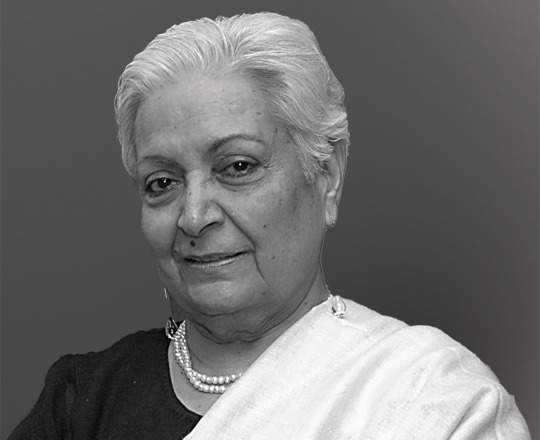
Google has honored Zarina Hashmi on her 86th birthday by creating a doodle related to her work and her significant contribution. Zarina Hashmi was a highly respected and accomplished artist who made significant contributions to the field of contemporary art.
Her work often explored themes of displacement, memory, and identity, and she was known for her ability to distill complex experiences into simple forms. Zarina died in London on 25 April 2020 from complications of Alzheimer’s disease.
Hashmi’s work has received critical acclaim throughout his career and has been displayed in galleries and museums around the world. In 2011, she was awarded the prestigious Joan Mitchell Foundation Grant for her contribution to contemporary art.
Despite his success, Hashmi has always remained humble and devoted to his craft.His work continues to inspire and challenge audiences. invites them to reflect on the complexities of identity and belonging in an increasingly globalized world.
About
Zarina Hashmi (1937–2020) was a renowned Indian-American artist known for her complex and minimalist works, which explored themes of migration, displacement and identity.
She was a distinguished and accomplished artist who led a life dedicated to her artistic pursuits. She continued to create art until her passing in 2020.
She was born on 16 July 1937 in a middle-class Muslim family in Aligarh, India.
Her father, Sheikh Ghulam Hashmi, was a mathematics professor at Aligarh Muslim University, and her mother, Nazneen Begum, was a homemaker. After the partition of India in 1947, she moved to Pakistan.
Zarina Hashmi was married to Indian artist Iqbal Jeffrey and has no children.
Education
Zarina Hashmi’s early education started in India and she studied Mathematics at Aligarh Muslim University. It was during her studies that she developed an interest in printmaking (graphic design) and later she moved to Bangkok, Thailand from where she studied printmaking at the Bangkok Art Institute.
In the early 1960s, Zarina moved to Paris, France, where she continued her artistic education at the École des Beaux-Arts and Atelier 17.
She began creating prints, drawings, and sculptures that reflected her personal sense of displacement and cultural identity. Used to find out experiences.
His work often featured maps, grids, and geometric shapes, reflecting his interest in mathematics and cartography. He also incorporated text and calligraphy into his works, drawing inspiration from his Muslim faith and the Urdu language, and explored themes of displacement and identity. topics explored.
Career
After returning to India in the 1970s, Hashmi began working as a printmaker at Garhi Studio in Delhi, and began to incorporate calligraphy into his works.
After moving to the United States in 1976, Zarina continued to create art exploring themes of displacement, memory, and identity.
Her work often consisted of geometric shapes, calligraphy and maps, and was deeply influenced by her experiences as a South Asian woman living in a foreign country.
During his time in America, Hashmi exhibited his work widely, including at the Venice Biennale, the Guggenheim Museum in New York, and the Whitney Museum of American Art.
He also held several teaching positions at institutions such as the University of California, San Diego, and the University of Pennsylvania.
The most famous of Hashmi’s works in America is “The Dividing Line”, a series of prints that trace the partition of India and Pakistan. and “Home is a Foreign Place”, a series of prints that reflect this idea of home and belonging.
While on the editorial board of the feminist arts magazine Heresies, Hashmi also contributed heavily to the “Women of the Third World” issue.
She has lived and worked in various cities around the world, including Bangkok, Tokyo, Paris, and New York.
She has exhibited her work internationally, including at the Venice Biennale, the Guggenheim Museum in New York, the Whitney Museum of American Art, and the British Museum.
Her work has also been exhibited internationally at major museums and galleries, including:
Venice Biennale (2011)
Guggenheim Museum in New York (2014)
Whitney Museum of American Art in New York
British Museum in London
Museum of Modern Art in New York
Art Institute of Chicago.
Guggenheim Museum, New York
Zarina Hashmi had an important role in the Guggenheim Museum in New York. In 2014, the museum organized a retrospective of her work titled “Zarina: Paper Like Skin”, showcasing her minimalist and abstract works that explored themes of displacement, memory and identity.
The exhibition featured more than 60 of Hashmi’s works, including prints, drawings, sculptures, and installations. The exhibition was curated by Sandhini Poddar and was the first major retrospective of Hashmi’s work in the United States.
In addition to retrospectives, Hashemi’s work is also housed in the permanent collection of the Guggenheim Museum, which includes many of his prints and sculptures.
Zarina Hashmi’s Books
Zarina: Paper Like Skin (2012) by Allegra Pesanti and Sandhini Poddar
Zarina: Her Life, Her Art by Pranabaranjan Ray (2004)
Zarina Hashmi: by Deepak Ananth and Grant Watson Edited Critical Dialogues (2017)
Zarina: Weaving Memory by Avik Sen (2016)
Zarina: Atlas of My World by Boon Hui Tan (2012)
These books provide insight into Hashmi’s artistic practice, her life experiences, and wider cultural and historical contexts. in which his work was created.
Zarina Hashmi “Atlas of My World”
Atlas of My World is a book by Zarina Hashmi which was published in 2012. The book is a collection of prints, drawings and photographs that reflect the themes of memory, displacement and identity that are central to his work.
The book includes reproductions of some of Hashmi’s most iconic works, including her “Home is a Foreign Place” series, which consists of abstract maps that explore the idea of home and belonging. It also includes personal photographs and sketches that provide insight into his creative process and life experiences.
In addition to the images, the book also includes essays from art historians and curators that provide context for Hashemi’s work and explore its importance in the wider field of contemporary art. Overall, “Atlas of My World” is a rich and insightful exploration of the life and work of one of the most important artists of our time.
Zarina Hashmi “The Way to My House”
“Directions to My House” is a print series by Zarina Hashmi that was created in 1999. The series consists of 36 prints, each containing a simple map or diagram that provides directions to the artist’s home in New York City.
The prints are created using traditional techniques such as woodblock printing and letterpress, and they incorporate elements from calligraphy and other forms of text-based art. The maps themselves are intentionally simplified and abstract, including only the most essential details.
Through this series, Hashmi explores the idea of home and belonging and the ways in which we create a sense of place in an increasingly complex and globalized world. The series has been screened internationally and is considered one of his most important works.
Zarina Hashmi “Letters from Home”
“Letters from Home” is a series of works by Zarina Hashmi that includes prints and sculptures. The series is based on the letters Hashmi received from his family in India while living abroad. The letters were a way for Hashmi to stay connected to her home and family, and her work explores themes of memory, displacement and longing.
The prints in the series include maps, diagrams, and text that refer to the letters, while the sculptures are made of materials such as paper, wood, and metal. “Letters from Home” is considered one of Hashemi’s most important works and has been displayed in museums and galleries around the world.
Awards and Achievements
Zarina Hashmi has received numerous awards and honors throughout her career, including:
President’s Award for Printmaking in India (1969)
Grand Prize Awards Bhopal, India (1989)
Scowhegan Medal for Sculpture (1991)
Lifetime Achievement Award (2004) for Art
Pakistan’s Highest Civilian Award for Art, Sitara-e-Imtiaz (2011)
Zarina Hashmi Quotes
Here are some notable quotes from Zarina Hashmi
Zarina Hashmi says she is interested in boundaries because she has seen what happens when they are broken.”
“Zarina feels the process of making art is a process of discovery”.
"She finds the idea of home interested, and what it means to belong to a place.”
“He has always been interested in the idea of memory, and how it shapes our sense of self.”
“For me, art communicates with the world It’s a way of doing. It’s a way of expressing my thoughts and feelings about the things that matter to me.”
"These quotes reflect Hashmi’s interest in themes such as boundaries, memory, identity and belonging, and her belief in the power of art as a means of communication and self-expression."
0 notes
Text
offtay's (+ x + junior) bangkok art biennale date 🥰🫶
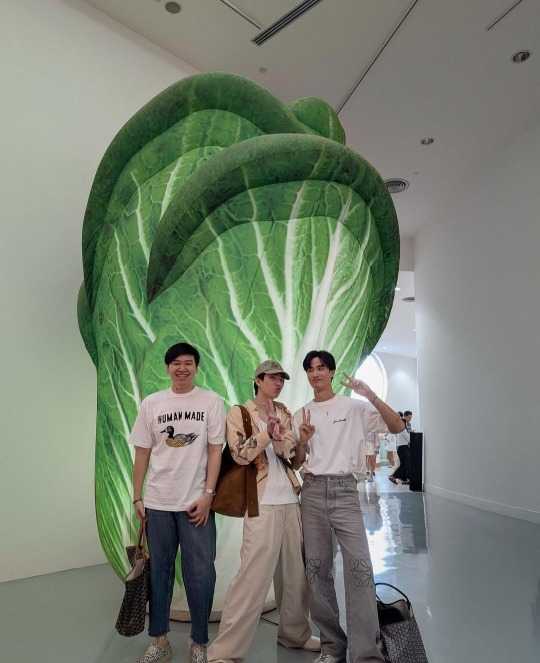
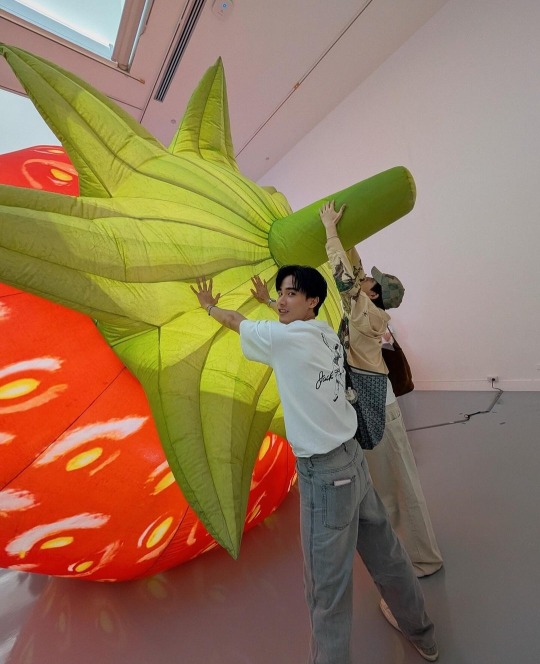
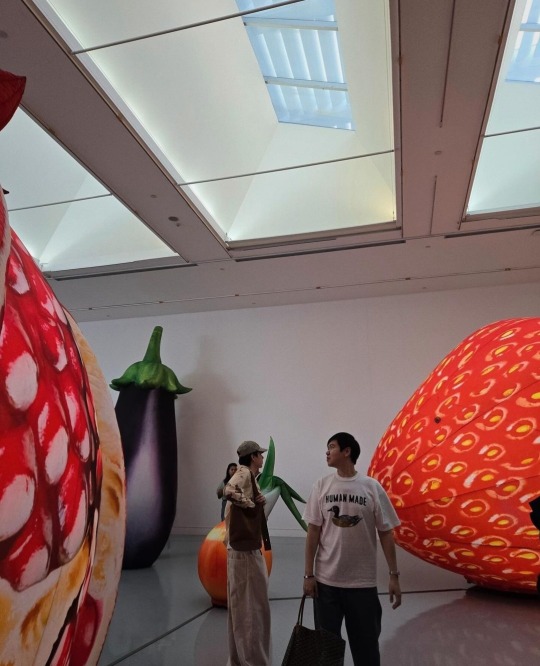
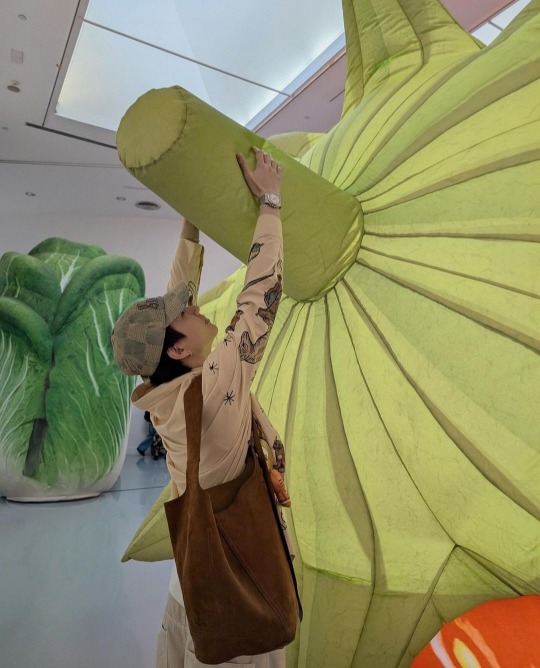
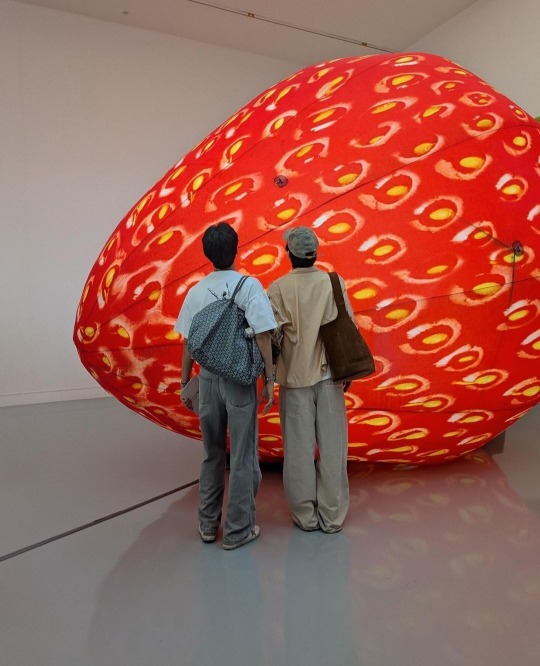
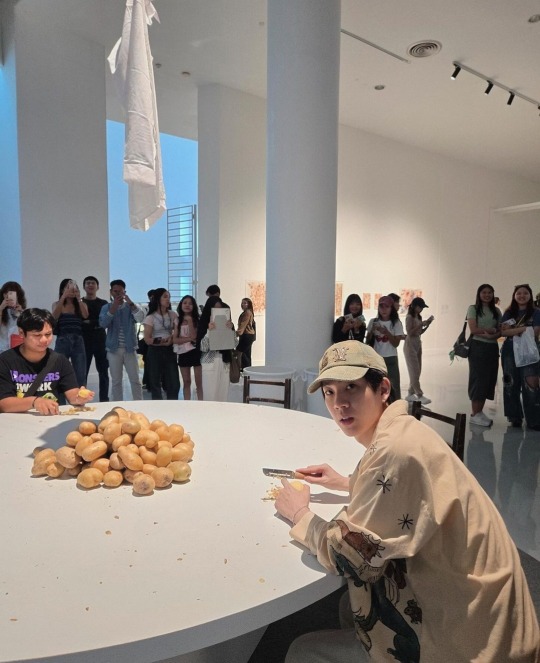


#offtay#off jumpol#tay tawan#x nuttapong#junior panachai#gmmtv#thai actors#2024#byofftay#bruh the fact that I could've stumbled onto them at the bacc randomly KILLS me#I missed out fr fr#also HOW TALL IS JUNIOR???? the internet says 181cm but that's not possible so wtf is up#anyways the pics are so cute I might try to recreate them when I can hehe
3 notes
·
View notes
Text

The ubiquitous plastic basket - a regular site in Thailand, it not always in these numbers. Bangkok Art Biennale
1 note
·
View note
Photo

1 note
·
View note
Text
0 notes


